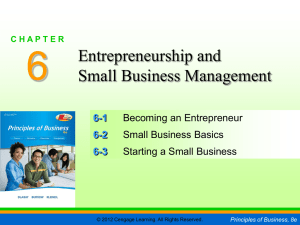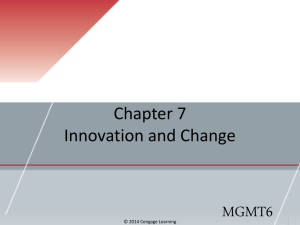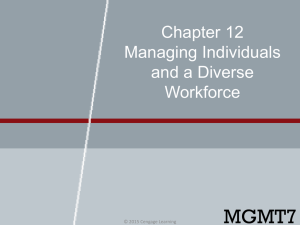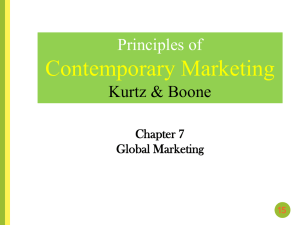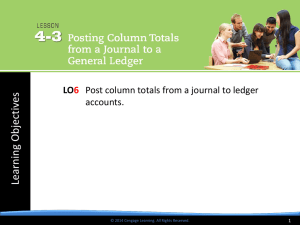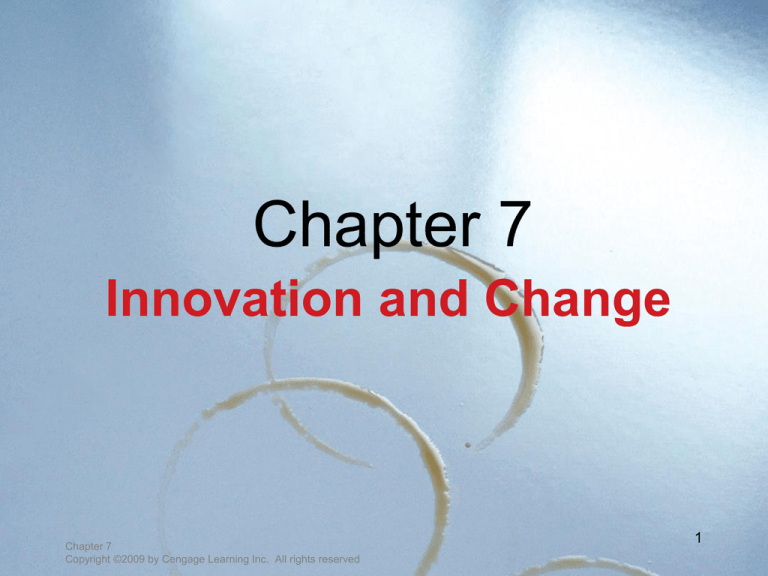
Chapter 7
Innovation and Change
Chapter 7
Copyright ©2009 by Cengage Learning Inc. All rights reserved
1
Why Innovation Matters
Technology
Cycles
Innovation
Streams
1
Chapter 7
Copyright ©2009 by Cengage Learning Inc. All rights reserved
4
Why Innovation Matters
1
1900-1910
airplane, plastic, air
conditioner
1911-1920
mammogram, zipper, sonar
1921-1930
talking movies, penicillin, jet
engine
1931-1940
radar, helicopter, computer
1941-1950
atomic bomb, bikini, transistor
1951-1960
DNA, oral contraceptive,
Tylenol
1961-1970
video recorder, handheld
calculator, computer mouse
1971-1980
compact disc, gene splicing,
laser printer
1981-1990
MS-DOS, space shuttle,
CD-ROM
1991-2000
taxol, Pentium processor,
Java
2001-Today
mapping of human genome,
first cloning of human
embryo
Adapted from Exhibit 7.1
Chapter 7
Copyright ©2009 by Cengage Learning Inc. All rights reserved
5
Technology Cycles
Technology Cycle
A cycle that begins with the “birth”
of a new technology and ends when
that technology reaches its limits
and is replaced by a newer, better
technology.
Piano Rolls
Records & LPs
Tape
CD’s
MP3, IPod
1.1
Chapter 7
Copyright ©2009 by Cengage Learning Inc. All rights reserved
6
S-Curves and Technological Innovation
Performance
Discontinuity
C
New
Technology
B
A
1.1
Effort
Adapted from Exhibit 7.2
Chapter 7
Copyright ©2009 by Cengage Learning Inc. All rights reserved
7
Requirements for
Sustainable Competitive Advantage
Valuable
Resources
Rare
Resources
Sustainable
Competitive
Advantage
Imperfectly
Imitable
Resources
NonSubstitutable
Resources
1
Chapter 7
Copyright ©2009 by Cengage Learning Inc. All rights reserved
Adapted from Exhibit 6.1
8
Innovation Streams
Innovation Streams
Patterns of innovation over time that can
create sustainable competitive advantage.
IBM 1401
IBM System/360
IBM System/370
IBM System/3
IBM AS/400
IBM Personal Computer
Technological Discontinuity
1.2
A scientific advance or unique combination
of existing technologies that creates a
significant breakthrough in performance or
function.
Chapter 7
Copyright ©2009 by Cengage Learning Inc. All rights reserved
9
Innovation Streams:
Technology Cycles over Time
Technological
Substitution
Era of
Incremental
Change (2)
Technological
Discontinuity
(2)
Variation
Selection
Era of
Ferment (2)
Dominant
Design (2)
Technological
Discontinuity (1)
Era of
Incremental
Change (1)
1.2
Variation
Selection
Dominant
Design (1)
Chapter 7
Copyright ©2009 by Cengage Learning Inc. All rights reserved
Era of
Ferment (1)
Also called Discontinuous Change
•Design Competition
Adapted from Exhibit 7.4
10
Innovation Streams
Technological
Discontinuities
Technological
Substitution
Discontinuous
Change
Design
Competition
Dominant Design
1.2
Chapter 7
Copyright ©2009 by Cengage Learning Inc. All rights reserved
11
Managing Innovation
Managing
Sources of
innovation
Managing During
Discontinuous
Change
Managing During
Incremental
Change
2
Chapter 7
Copyright ©2009 by Cengage Learning Inc. All rights reserved
12
Managing Sources of Innovation
Creative work environments
Workplace cultures in which workers
perceive that new ideas are encouraged
Flow
The psychological state of effortlessness
in which you become absorbed in your
work and time seems to pass quickly
2.1
Chapter 7
Copyright ©2009 by Cengage Learning Inc. All rights reserved
13
Components of Creative Work
Environments
Flow
2.1
Chapter 7
Copyright ©2009 by Cengage Learning Inc. All rights reserved
14
Adapted from Exhibit 7.5
Doing the Right Thing
Give Credit, Don’t Take It
Stealing others’ ideas wrong, AND
Nothing kills a creative work environment faster
So…whether or not you’re the boss,
give credit where it’s due.
2.1
Chapter 7
Copyright ©2009 by Cengage Learning Inc. All rights reserved
15
Expanding Sources of Innovation
Companies can avoid
internal impediments to
creativity by looking
outside the organization.
Customers are an
important source of
innovation.
Sportime International
followed a customer idea
and created Hands-On
basketballs for children
who need help learning
how to shoot.
Chapter 7
Copyright ©2009 by Cengage Learning Inc. All rights reserved
16
Managing Innovation
During Discontinuous Change
Experiential approach to
innovation
innovation is occurring within
an uncertain environment
the key to innovation is to use:
2.2
intuition
flexible options
hands-on experience
Chapter 7
Copyright ©2009 by Cengage Learning Inc. All rights reserved
17
Experiential Approach to
Innovation
Design Iterations
Testing
Parts of
Experiential
Approach
Milestones
Multifunctional Teams
Powerful Leaders
2.2
Chapter 7
Copyright ©2009 by Cengage Learning Inc. All rights reserved
18
Managing Innovation During
Incremental Change
If you know where you’re going…
Compression approach to innovation
assumes that innovation is a predictable
process that can be planned in steps
IBM System/360 Model 25
IBM System/360 Model 30
IBM System/360 Model 40
IBM System/360 Model 50
IBM System/360 Model 65
Generational change
based on incremental improvements to
a dominant technological design and
achieving backward compatibility with
older technology
2.3
Chapter 7
Copyright ©2009 by Cengage Learning Inc. All rights reserved
19
Compression Approach
to Innovation
Planning
Supplier Involvement
Parts of
Compression
Approach
Shortening Time of
Individual Steps
Overlapping Steps
Multifunctional Teams
2.3
Chapter 7
Copyright ©2009 by Cengage Learning Inc. All rights reserved
20
Managing Innovation
Experiental
Approach
Environment
Uncertain discontinuous
change:
technological substitution
and design competition
Certain incremental change
established technology
(i.e., dominant design)
Speed
Performance Improvements
New dominant design
Speed
Lower costs
Incremental improvements
in performance of dominant
design
Build something new,
different, and better
Compress time/steps needed
to bring about small
improvements
Goals
Approach
2.3
Compression
Approach
Design iterations
Testing
Milestones
Multifunctional teams
Steps
Chapter 7
Powerful leaders
Copyright ©2009 by Cengage Learning Inc. All rights reserved
Planning
Supplier involvement
Shorten time of steps
Adapted
from Exhibit 7.6steps
Overlapping
21
Multifunctional teams
Biz Flix: October Sky
Are Homer and his friends
working toward
discontinuous change or
incremental change?
Which approach to
innovation best describes
what the “Rocket Boys” are
doing?
Chapter 7
Copyright ©2009 by Cengage Learning Inc. All rights reserved
Take Two Video
Click
22
Change
Managing it within your organization
4
Chapter 7
Copyright ©2009 by Cengage Learning Inc. All rights reserved
24
Five Stages of Organizational
Decline
Blinded
Failure to recognize change happening
Inaction
Recognize change but
slow to react or react
inappropriately
Recognize change but take no action
Faulty
Action
Crisis
Bankruptcy/reorganization
Dissolution
Bye-bye
3
Chapter 7
Copyright ©2009 by Cengage Learning Inc. All rights reserved
25
Managing Change
Change Forces
Why resist?
Change
* Self Interest
* Misunderstanding
* Distrust
* Intolerance to change
Resistance Forces
4
Chapter 7
Copyright ©2009 by Cengage Learning Inc. All rights reserved
26
Managing Change
Managing
resistance
to change
What not
to do when
leading change
Different change
tools and
techniques
4
Chapter 7
Copyright ©2009 by Cengage Learning Inc. All rights reserved
27
Managing Resistance to
Change
Unfreezing
• Share reasons
• Empathize
• Communicate
Change
Intervention
•
•
•
•
•
•
•
Refreezing
Benefits
Champion
Input
Timing
Security
Training
Pace
4.1
Chapter 7
Copyright ©2009 by Cengage Learning Inc. All rights reserved
28
Managing Resistance to
Change
Education and Communication
Participation
Negotiation
Managerial Support
4.1
Coercion
Chapter 7
Copyright ©2009 by Cengage Learning Inc. All rights reserved
29
Errors Made when Leading
Change
Unfreezing
1. Not establishing a great enough sense of urgency.
2. Not creating a powerful enough guiding coalition.
Change
3. Lacking a vision.
4. Undercommunicating the vision by a factor of 10.
5. Not removing obstacles to the new vision.
6. Not systematically planning for and creating short-term wins.
Refreezing
7. Declaring victory too soon.
4.2
8. Not anchoring changes in the corporation’s culture.
Chapter 7
Copyright ©2009 by Cengage Learning Inc. All rights reserved
Adapted from Exhibit 7.8
30
Change Tools and Techniques
Results-Driven Change
General Electric Workout
Transition Management Teams
Organizational Development
4.3
Chapter 7
Copyright ©2009 by Cengage Learning Inc. All rights reserved
31
Results-Driven Change
1. Create measurable short-term goals to improve performance
2. Use action steps only if likely to improve performance
3. Stress the importance of immediate improvements
4. Consultants and staffers should help managers achieve
quick improvements in performance
5. Test action steps to see if they yield improvements
4.3
6. It takes few resources to get results-driven change started
Chapter 7
Copyright ©2009 by Cengage Learning Inc. All rights reserved
Adapted from Exhibit 7.9
32
General Electric Workout
Day
1. Boss discusses agenda and targets specific
business problems, then leaves
2. Outside facilitator works with
teams, who debate solutions
3. “Town Meeting”
teams make suggestions
boss must decide on the spot—
agree, say no, or ask for more information
4.3
Chapter 7
Copyright ©2009 by Cengage Learning Inc. All rights reserved
33
Transition Management Team
A team of employees whose full-time
job is to manage and coordinate change
Anticipate and manage employee
reactions to change
Work with the CEO to…
decide on change projects
select and evaluate people in charge
make sure change projects are
complementary
4.3
Chapter 7
Copyright ©2009 by Cengage Learning Inc. All rights reserved
34
Transition Management Team
Primary Responsibilities of TMT
1.
2.
3.
4.
5.
6.
7.
4.3 8.
Establish a context for change and provide guidance.
Stimulate conversation.
Provide appropriate resources.
Coordinate and align projects.
Ensure congruence of messages, activities, policies,
and behaviors.
Provide opportunities for joint creation.
Anticipate, identify, and address people problems.
Prepare the critical mass.
Chapter 7
Copyright ©2009 by Cengage Learning Inc. All rights reserved
Adapted from Exhibit 7.10
35
Organizational Development
A philosophy and collection of
planned change interventions
Designed to ensure organizations
long-term health and performance
Change Agent
4.3
the person formally charged with guiding
a change effort
can be an internal or external person
Chapter 7
Copyright ©2009 by Cengage Learning Inc. All rights reserved
37
Kinds of OD Interventions
LARGE SYSTEM INTERVENTIONS
Sociotechnical systems
Survey feedback
SMALL GROUP INTERVENTIONS
Team building
Unit goal setting
PERSON-FOCUSED INTERVENTIONS
Counseling/Coaching
Training
4.3
Chapter 7
Copyright ©2009 by Cengage Learning Inc. All rights reserved
Adapted from Exhibit 7.12
39
What Really Works
Change the Work Setting or Change the People?
Changing the Work Setting
10% 20% 30% 40% 50% 60% 70% 80% 90% 100%
probability of success 55%
Changing the People
10% 20% 30% 40% 50% 60% 70% 80% 90% 100%
probability of success
57%
Changing Individual Behavior & Organizational Performance
10% 20% 30% 40% 50% 60% 70% 80% 90% 100%
probability of success
76%
Chapter 7
Copyright ©2009 by Cengage Learning Inc. All rights reserved
40


